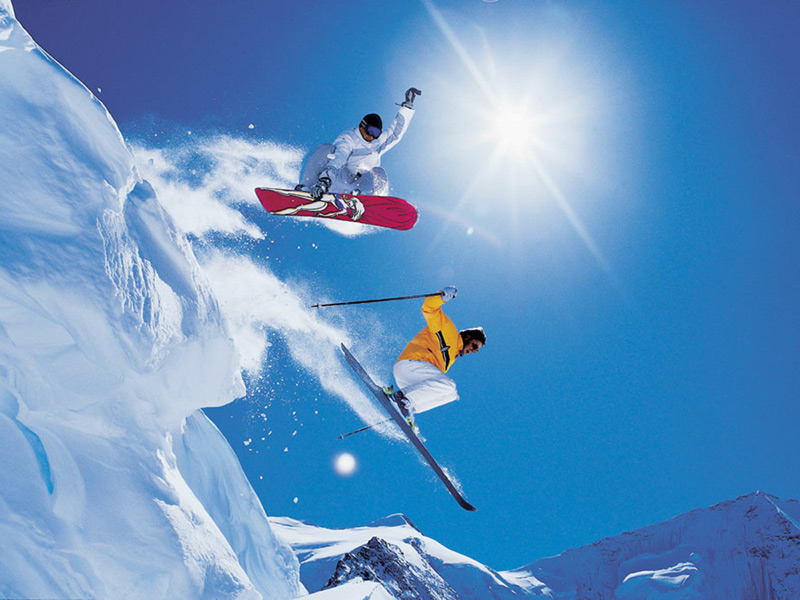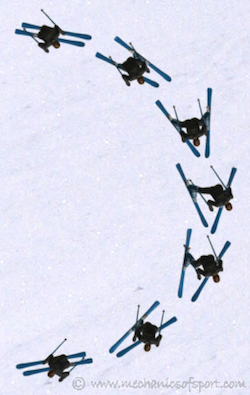“Skiing is easier to learn, but harder to master...
whereas snowboarding is harder to learn, but easier to master.”
This is a common claim you will hear in the world of snowsports and, while different people can take to different sports, it's generally true.
We've been running ski instructor courses, snowboard instructor courses, paid instructor internships and ski/snowboard improver courses, since 2003 - so we've come across a lot of people learning!
With skiing, a beginner’s technique can be broken down into a modular approach but its perfection will require you to become extremely technical.
With snowboarding, it’s all about getting on your edges (both heel and toe edges). This is the hardest part but, once it's achieved, you have the fundamental technique of the sport nailed - and can reach a pretty impressive level pretty quickly, especially if you’re brave!
The first few days of learning to ski or snowboard
For the first day or two, skiing is easier to pick up than snowboarding. This is largely because skiing is more intuitive for beginners than snowboarding, for two main reasons:
Separation:
With skiing, your legs remain separated so at low speeds, you can throw one leg out if you start to fall to help re-balance yourself. Snowboarding, on the other hand, requires that your feet are attached the board and this can feel awkward and restrictive at first - and can take a little getting used to. If you start to fall, you will inevitably fall and take the hit.
Body position:
Skiing is done with a straightforward, straight-on stance; the beginner skier has total peripheral vision and can see exactly where he or she is going, and everything that is in front, including other people and objects. On the other hand, snowboarding stances are side-on and so the beginner has less peripheral vision, seeing only around 50% of what is in front while travelling down the slopes. This can also take a little bit of getting used to.
Dream job alert! Do you think you have what it takes to teach beginners to ski or snowboard? Get qualified by taking one of our snowboard or ski instructor courses in Canada, New Zealand or France.
Is it easier to progress in skiing or snowboarding?
Snowboarding:
Once these two (mainly psychological) obstacles are overcome, beginner snowboarders should be able to progress relatively quickly in the sport. The attachment of the feet to the snowboard, awkward at first, becomes an advantage - as skiers find that crossing their skis can become an issue; keeping the skis apart is a skill in itself.
Beginner snowboarders, blessed with a monoski, don’t have to worry about this. So once they’ve grasped the basics of making a turn – turn shoulders, which turns hips, which turns ankles and feet, which turns snowboard - then they can start to hit the proper slopes. The next step is to work on improved balance and increased speed. And increasing speed actually makes turning even easier due to there being less contact between the base of the board and the snow, which decreases resistance when turning.
For most beginner snowboarders, the basics of riding down and making simple turns should be achievable within a week or two. So Increasing speed, finessing turns and taking your riding to the next level on the slopes, in the park (and in the backcountry), is what you will spend the rest of your time doing!
Skiing:
For skiers, however, the tough work starts after the one or two-day honeymoon period and it is likely to take a lot longer than it would for snowboarders to build up that basic level of skill. Having two separate skis on two separate legs, at first a benefit, starts to become a problem because moving both legs simultaneously, in symmetry and in harmony, takes some time to achieve.
Beginner skiers will start off with snowplough (a.k.a pizza) – which gets the tips of the skis together, tails of the skis apart - and straight skis (a.k.a. french fries) on a nursery slope to get the beginner used to travelling straight down the slopes at speed. The next step is the snowplough turn (see image), which reintroduces the snowplough technique to get skiers to move one ski outwards so a turn can be completed in the opposite direction.
The snowplough turn (Image credit: mechanicsofsport.com)
Unlike the fast progression of snowboarders, in most cases beginner skiers are doing well to progress past snowplough turns by the end of week one. However even though progression is more difficult and technical, when skiers do begin to take on blue and red runs they will find a sport that continues to challenge technique and skill. And mastery, even though difficult, is very rewarding because of the difficulty getting there. When it comes to progressing to the next level, as an intermediate skier, it can be a real challenge!
Do I need to be more fit to ski or to snowboard?
You need to be pretty fit to be a good skier or snowboarder. But to begin with, skiing is a bit more demanding on the legs and thighs, whereas snowboarding tends to need more core strength, as the upper body is more involved with turning and balance. Here are few recommended exercises if you're doing one or the other - but it helps to develop overall fitness to do both:
Skiing:
Cycling is an option recommended by Snowskool, especially for skiers, as it strengthens the legs but has a lower impact than running on knees and joints. General leg strengthening exercises are also going to help.
Snowboarding:
Core strengthening exercises that focus on the abdominal muscles and lower back will improve overall fitness, balance and injury prevention – and are especially useful for snowboarders. There are some great examples of core strengthening exercises, from simple crunches to pilates, but paddleboarding is another popular sport (on a board) that offers a great core work out off-season.
Another thing to bear in mind is that beginners often fall more, and harder, when snowboarding. So learning to snowboard can be more forgiving on the body if you're a bit younger - or in good physical shape.
Prepare for a good addiction!
For many people, snowsports become quite addictive – a skier or snowboarder looks forward to a snow holiday in the mountains with the same desperation as a beach bum looks forward to a summer holiday by the sea. And regardless if you choose skiing or snowboarding, if you get past the beginner stage and get really into it, it is quite likely that the sport will become a central part of your life. You will want to keep going and become an expert.
Your first ski or snowboard trip
Whichever sport you choose to take up, our best piece of advice is to be as prepared as possible. That way your enjoyment and therefore progression will be better. Think about your fitness, borrowing warm/comfy gear and getting a course of ski or snowboard lessons at an indoor slope. A ski instructor course or snowboard instructor course might not be right for you just yet but, our courses in Canada's Banff and Big White are suitable for confident skiers/boarders from three weeks of experience, so not too far off!
Dream job alert! Do you think you have what it takes to teach beginners to ski or snowboard? Get qualified by taking one of our snowboard instructor courses or ski instructor courses in Canada, New Zealand or France.
Unlike other addictions, this one is not so bad, you are out exercising in the mountains, in the fresh air and having a total blast to boot. Skiing and snowboarding both have a big social side with the apres scene being a big part of both sports so you’ll make a lot of friends along the way.
Already decided to ski or snowboard?
Learn to teach others how to ski or snowboard with a ski instructor course, or a snowboard instructor course - or share this article with someone who would be great at the job.
And if you're interested in learning more about skiing or snowboarding as a career then here's some info on life as a ski instructor and ski and snowboard instructor salaries.

